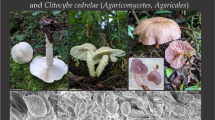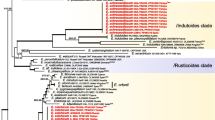Abstract
Analyses of DNA sequences from the internal transcribed spacer (ITS) region of the nuclear rDNA and from a portion of a manganese-dependent peroxidase gene were used to assess the species inAmylostereum, including isolates from the mycangia of horntails, decay, and basidiomes. Four species are recognized:A. areolatum, A. chailletii, A. laevigatum, andA. ferreum. An unidentifiedAmylosterum isolate from the mycangium ofXoanon matsumurae had an ITS sequence identical to that ofA. areolatum. Another unidentifiedAmylostereum isolate from the mycangium ofSirex areolatus was nearA. laevigatum, which appears to be the mycangial symbiont for those horntails attacking cedar-like trees. The other horntail isolates, primarily from Pinaceae, proved to be eitherA. areolatum orA. chailletii. The DNA sequences ofEchinodontium tinctorium, E. tsugicola andE. japonicum were similar to those of theAmylostereum species, andAmylostereum species are now recognized as members of the family Echinodontiaceae rather than the family Stereaceae.Echinodontium taxodii was found to be distinct from the Echinodontiacaea andStereum, andE. taxodii is recognized as aLaurilia species.
Similar content being viewed by others
Literature cited
Boidin, J. and Lanquetin, P. 1984. Le genreAmylostereum (Basidiomycetes) intercompatibilités partielle entre especes allopatriques. Bull. Soc. Mycol. France100: 211–236.
Boidin, J., Mugnier, J. and Canales R. 1998. Taxonomic molecular des Aphyllophorales. Mycotaxon66: 445–491.
Breitenbach, J. and Kranzlin, F. 1988. Fungi of Switzerland, vol. 2. Non-gilled Fungi. Verlag Mykologia, Lecerne.
Chamuris, G. 1988. The non-stipitate stereoid fungi in the northeastern United States and adjacent Canada. Mycol. Mem. No. 14. J. Cramer, Stuttgart., pp. 41–45.
Davidson, R. W., Lentz, P. L. and Mckay, H. H. 1960. The fungus causing pecky cypress. Mycologia52: 260–279.
DeScenzo, R. A. and Harrington, T. C. 1994. Use of (CAT)5 as a DNA fingerprinting probe for fungi. Phytopathology84: 534–540.
Donk, M. A. 1961. Four new families of Hymenomycetes. Persoonia1: 405–407.
Donk, M. A. 1964. A conspectus of the families of Aphyllophorales. Persoonia3: 199–324.
Eriksson, J., Hjortstam, K. and Ryvarden, L. 1978. The Corticiaceae of North Europe, vol. 5. pp. 890–893. Fungiflora, Oslo.
Eriksson, J. and Ryvarden, L. 1973. The Corticiaceae of North Europe, vol. 2., pp. 90–95, Fungiflora, Oslo.
Furniss, R. L. and Carolin, V. M. 1977. Western Forest Insects. USDA For. Serv. Misc. Publ. No. 1339: 453–457.
Gardes, M. and Bruns, T. D. 1993. ITS primers with enhanced specificity for basidiomycetes—application to the identification of mycorrhizae and rusts. Mol. Ecol.2: 113–118.
Gaut, I. P. C. 1969. Identity of the fungal symbiont ofSirex noctilio. Aust. J. Biol. Sci.22: 905–914.
Gaut, I. P. C. 1970. Studies of siricids and their fungal symbionts. PhD thesis, Univ. Adelaide, Australia.
Gilbert, J. M. and Miller, L. W. 1952. An outbreak ofSirex noctilio F. in Tasmania. Aust. For.16: 63–69.
Gilbertson, R. L. and Ryvarden, L. 1986. North American Polypores, vol. 1., pp. 251–255. Fungiflora, Oslo.
Gilmoure, J. W. 1965. The life cycle of the fungal symbiont ofSirex noctilio. N. Z. J. For.10: 80–89.
Ginns, J. and Lefebvre, M. N. L. 1993. Lignicolous corticioid fungi (Basidiomycota) of North America, systematics, distribution, and ecology. Mycol. Mem., No. 19, p. 21. APS Press, St. Paul, Minnesota.
Gross, H. L. 1964. The Echinodontiaceae. Mycopathol. Mycol. Appl.24: 1–26.
Harrington, T. C. and Wingfield, B. D. 1995. A PCR-based identification method for species ofArmillaria. Mycologia87: 280–288.
Harrington, T. C., Stenlid, J. and Korhonen, K. 1997. Evolution in the genusHeterobasidion. 9th Intern. Conf. of Root and Butt Rots of Forest Trees, Carcans-Maubuisson, France Sept. 1–7, pp. 63–74.
Hibbett, D. S. and Donoghue, M. J. 1995. Progress toward a phylogenetic classification of the Polyporaceae through parsimony analysis of mitochondrial ribosomal DNA sequences. Can. J. Bot.73: S853-S861.
Hsiau, P. T. 1996. The taxonomy and phylogeny of the mycangial fungi fromDendroctonus brevicomis andD. frontalis (Coleoptera: Scolytidae). PhD thesis, Iowa State University, USA.
Imazeki, R. 1935. Studies onEchinodontium Ellis et Everhart. J. Jpn. Bot.11: 514–521.
Jülich, W. 1981. Higher taxa of Basidiomycetes. Biblio. Mycol.85. J. Cramer, Stuttgart.
Maijala, P., Harrington, T. C. and Raudaskoski, M. 1998. Peroxidase gene structure and gene trees inHeterobasidion. Fourth Meeting on the Genetics and Cellular Biology of Basidiomycetes, Nijmegen, The Netherlands March 27–30, pp. 62–70.
Parmasto, E. 1968. Conspectus systematis corticiacearum. Inst. Zool. Bot., Acad. Sci. R. P. S. S. Estonicae. Tartu.
Pouzar, Z. 1959. New gerena of higher fungi III. Ceska Mycol.13: 10–19.
Ryvarden, L. 1991. Genera of Polypores. Nomenclature and taxonomy, pp. 68–69. Fungiflora, Oslo.
Sano, A., Mihara, Y. and Ito, S. 1995. The fungus isolated from the mycangia ofUrocerus japonicus andU. antennatus. Trans. 43th Mtg. Chubu Br. Jpn. For. Soc., pp. 125–126. (In Japanese.)
Slippers, B., Wingfield, M. J., Coutinho, T. A. and Wingfield, B. D. 1998. The identify and possible origin of theAmylostereum symbiont ofSirex noctilio in South Africa. 7th Intern. Congr. of Plant Pathology (ICPP), Edinburgh, Scotland Aug. 9–16,3: 55.
Swofford, D. L. 1998. PAUP*: Phylogenetic Analysis Using Parsimony (* and other methods), ver. 4, Sinauer Associates, Sunderland, Massachusetts, U.S.A.
Tabata, M. and Abe, Y. 1997.Amylostereum laevigatum associated with the Japanese horntail,Urocerus japonicus. Mycoscience38: 421–427.
Tabata, M. and Abe, Y. 1999.Amylostereum laevigatum associated with a horntail,Urocerus antennatus. Mycoscience40: 535–539.
Terashita, T. 1970. A Basidiomycete symbiotic to a siricid in Japan. J. Jpn. For. Soc.52: 313–316. (In Japanese.)
Vasiliauskas, R., Johannesson, H. and Stenlid, J. 1999. Molecular relationships within the genusAmylostereum as determined by internal transcribed spacer sequences of the ribosomal DNA. Mycotaxon71: 155–161.
Vibrans, A. 1991. Biological control of the woodwasp (Sirex noctilio) in Brazil. Forstarchiv62: 97–99.
White, T. J., Bruns, T., Lee, S. and Taylor, J. 1990. Amplification and direct sequencing of fungal ribosomal RNA genes for phylogenetics. In: PCR protocols: a guide to methods and application, (ed. by Innis, M. A., Gefand, D. H., Sninsky, J. J. and White, T. J.), pp. 315–322. Academic Press, California.
Wu, S. H. 1995. Two new genera of corticioid basidiomycetes with gloeocystidia and amyloid basidiospores. Mycologia87: 886–890.
Author information
Authors and Affiliations
About this article
Cite this article
Tabata, M., Harrington, T.C., Chen, W. et al. Molecular phylogeny of species in the generaAmylostereum andEchinodontium . Mycoscience 41, 585–593 (2000). https://doi.org/10.1007/BF02460925
Received:
Issue Date:
DOI: https://doi.org/10.1007/BF02460925




